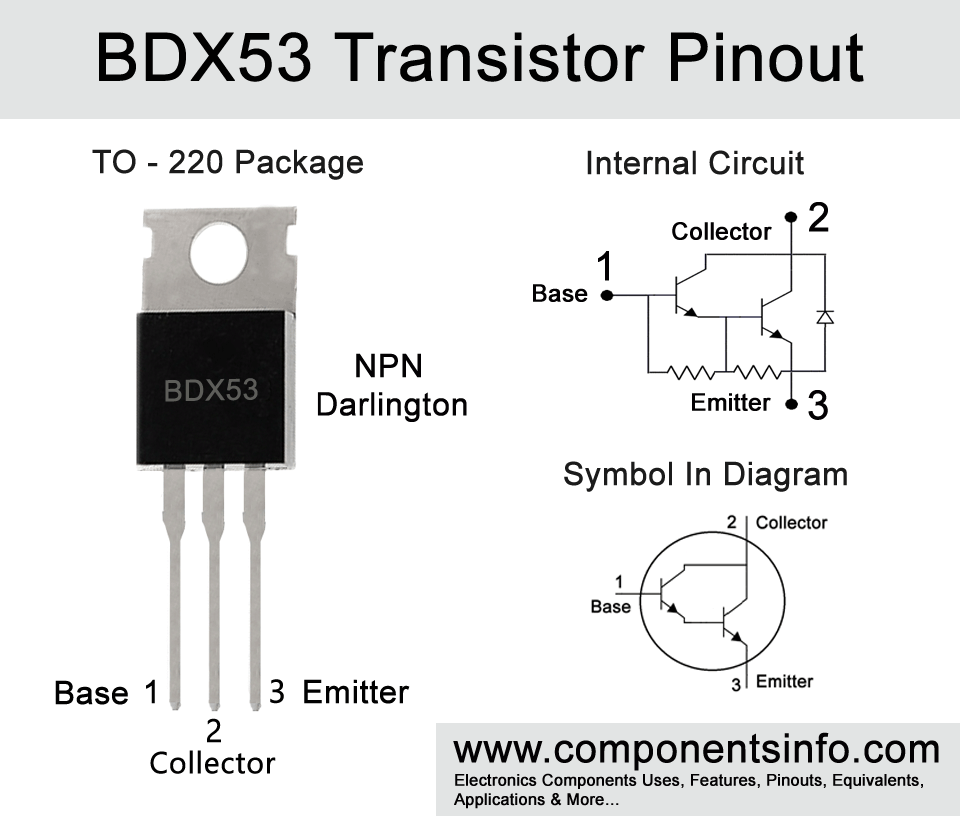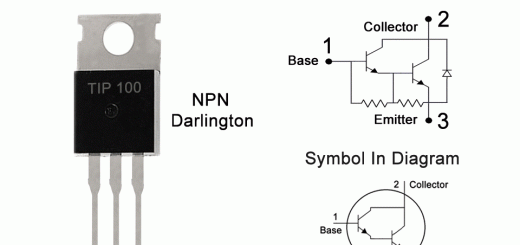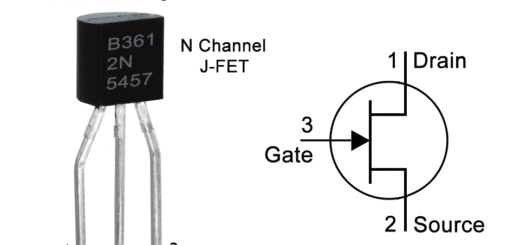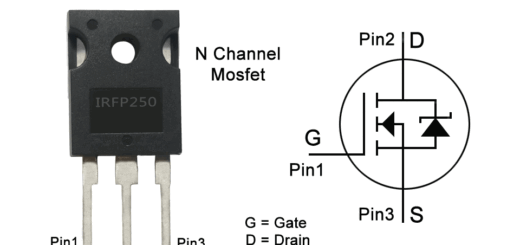BDX53 Transistor Pinout, Equivalents, Applications, Features and Other Characteristics
BDX53 is another transistor from BDX53x series of NPN Darlington transistors. In this post we are going to discuss about BDX53 transistor pinout, equivalents, applications, features and other characteristics.
Absolute Maximum Ratings:
- Package Type: TO-220
- Transistor Type: NPN Darlington
- Max Collector Current(IC): 8A
- Max Collector-Emitter Voltage (VCEO): 45V
- Max Collector-Base Voltage (VCBO): 45V
- Max Emitter-Base Voltage (VEBO): 5V
- Max Collector Power Dissipation (Pc): 60 Watt
- Minimum DC Current Gain (hFE): 750
- Max Storage & Operating temperature: -65 to +150 Centigrade
PNP Complementary:
PNP Complementary of BDX53 is BDX54
Replacement and Equivalent:
TIP131, TIP101, TIP132, TIP102, BDX53C, BDX33B, BDW93B/C, BDX33C, MJF6388, BDW73B/C, BDW93B/C, BDW42, BDW43, BDS41, 2N6532, NTE2343, NTE263, 2N6388, BD269A, 2SD1895, 2SD498.
BDX53 Transistor Explained / Description:
BDX53 is another transistor of BDX53x series of NPN Darlington transistors designed to use in switching, audio amps, and hammer driver applications. Other transistors of the series are BDX53A, BDX53B, BDX53C. All the transistors of the series are almost identical except for some of their voltage ratings but they can still be used alternatively and perform the same. The pin configuration of the transistor are as follow: the first pin is Base, second pin is Collector and the third pin is Emitter.
The absolute maximum ratings of the transistor are as follow: collector-emitter voltage is 45V, collector-base voltage is also 45V, collector current is 8A, base current is 0.2A, emitter-base voltage is 5V and collector dissipation is 60W.
Although the transistor is designed to use in switching, amplifier and hammer applications but can also be used in wide variety of other general purpose applications which are mentioned under the “Applications” heading below.
Where We Can Use it & How to Use:
Besides the main applications of BDX53, the transistor can be used in circuits such as voltage converters, voltage regulators, inverters and many other general purpose applications.
BDX53 can be used for both switching and amplification purposes. For using it as a switch first of all check its pin layout. After checking the pin layout connect its Base pin (through a 1K resistor) with the signal source from which you want to control the load, connect the Emitter pin with the negative supply of the circuit and the Collector pin with the negative point of the of the load and the positive point of the load will be connected with the positive supply of the circuit.
For using it as a simple amplifier connect its Emitter pin with the negative supply, connect the Base pin with the signal source (through a 102 ceramic capacitor) and the Collector pin with the negative point of the speaker and the positive point of the speaker will be connected with the positive supply of the circuit.
Applications:
LED Drivers
Audio Amplifiers
Pulse Generator
Switching Circuits
Voltage inverters
Motor Control
Voltage Regulation
DC to DC Converters
Battery Operated Applications
Safe Operating Guidelines:
Operating guidelines of the transistor are as follow.
- For long term performance it is important to not use the transistor to its absolute maximum ratings and always stay 20% below from these absolute max ratings.
- So the maximum collector to emitter voltage is 45V therefore do not drive load of more than 36V.
- The max collector current is 8A therefore do not drive load of more than 6.4A.
- The max temperature range of the transistor is -65°C to 150°C so it is important to maintain the inside and outside temperature of the transistor between this range.
Datasheet:
To download the datasheet just copy and paste the below link in your browser.
https://datasheetspdf.com/pdf-down/B/D/X/BDX53_FairchildSemiconductor.pdf



